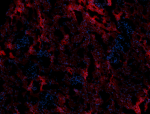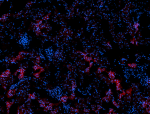- Clone
- 10D6 (See other available formats)
- Regulatory Status
- RUO
- Other Names
- CD326, EGP40, MIC18, TROP1, KSA
- Isotype
- Mouse IgG1, κ
- Ave. Rating
- Submit a Review
- Product Citations
- publications

-

Rat frozen kidney section was fixed with 4% paraformaldehyde for ten minutes at room temperature and blocked with 5% FBS for 30 minutes at room temperature. Then, the section was stained with 10 µg/mL purified CD326 (clone 10D6) overnight at 4°C, followed by 2.5 µg/mL of Alexa Fluor™ 594 anti-mouse IgG (Poly4053) (red) for one hour at room temperature. The image was captured by 10X objective.
Ep-CAM (CD326) mediates calcium-independent homophilic cell to cell adhesion. It may also function as a growth factor receptor. It is thought to be involved in maintaining cells in position during proliferation. Expression of Ep-CAM seems to correlate inversely with the level of E-cadherin (CD324). Ep-CAM is considered important in tumor biology.
Product DetailsProduct Details
- Verified Reactivity
- Rat
- Antibody Type
- Monoclonal
- Host Species
- Mouse
- Formulation
- Phosphate-buffered solution, pH 7.2, containing 0.09% sodium azide
- Preparation
- The antibody was purified by affinity chromatography.
- Concentration
- 0.5 mg/mL
- Storage & Handling
- The antibody solution should be stored undiluted between 2°C and 8°C.
- Application
-
IHC-F - Quality tested
- Recommended Usage
-
Each lot of this antibody is quality control tested by immunohistochemical staining on frozen tissue sections. For immunohistochemistry, a concentration range of 5 - 10 µg/mL is suggested. It is recommended that the reagent be titrated for optimal performance for each application.
- RRID
-
AB_2876582 (BioLegend Cat. No. 251002)
Antigen Details
- Function
- Mediates calcium-independent homophilic cell-cell adhesion
- Interaction
- CD326 displays hemophilic binding.
- Ligand/Receptor
- CD305 (LAIR-1), CD306 (LAIR-2), and Ep-CAM
- Cell Type
- Embryonic Stem Cells, Epithelial cells
- Biology Area
- Immunology, Stem Cells
- Molecular Family
- Adhesion Molecules, CD Molecules
- Gene ID
- 171577 View all products for this Gene ID
- UniProt
- View information about CD326 on UniProt.org
Related Pages & Pathways
Pages
Related FAQs
Other Formats
View All CD326 Reagents Request Custom Conjugation| Description | Clone | Applications |
|---|---|---|
| Purified anti-rat CD326 (Ep-CAM) | 10D6 | IHC-F |
| Alexa Fluor® 594 anti-rat CD326 (Ep-CAM) | 10D6 | IHC-F |
| Alexa Fluor® 647 anti-rat CD326 (Ep-CAM) | 10D6 | IHC-F |
Compare Data Across All Formats
This data display is provided for general comparisons between formats.
Your actual data may vary due to variations in samples, target cells, instruments and their settings, staining conditions, and other factors.
If you need assistance with selecting the best format contact our expert technical support team.
-
Purified anti-rat CD326 (Ep-CAM)

Rat frozen kidney section was fixed with 4% paraformaldehyde... -
Alexa Fluor® 594 anti-rat CD326 (Ep-CAM)

Rat frozen kidney section was fixed with 4% paraformaldehyde... -
Alexa Fluor® 647 anti-rat CD326 (Ep-CAM)

Frozen rat kidney section was fixed with 4% paraformaldehyde...








Follow Us